“Word of the Year” ….. A word that represents a way of being, an attitude or a mindset that serves as a road sign guiding you towards a goal you want to achieve before the end of the year.
I LOVE having a word of the year! And not just any old word. I put a lot of thought into choosing my word (or phrase) so that it aligns perfectly with my goals for the coming year.
Why I began using a word of the year
I began choosing a word of the year a few years ago to help me stay on track with my goals. I’d been really busy at that time, juggling lots of different contracts and spending all my time trying to please every organisation using their own systems. I always felt behind, disorganised, and I put increasing pressure on myself to do all the things for everyone.
I yearned for something simpler. I wanted to feel calm, organised and satisfied with my work again. I wanted everything to be simpler but I felt stuck because I didn’t know how to get to that point. When I took the time to reflect, it was a pretty obvious decision to choose “simple” as my word of the year!
Now, simple isn’t something you do. It’s a state of being or a mindset that guides the actions you take, a bit like a train track that keeps the train heading in the right direction. So, when I was faced with choices in the following year, I allowed my word of the year to guide me. I chose simple over complicated. I let go of all sorts of things that were in the way of me living a simple, calm and organised life.
My word of the year was a true shining light for me that year. Choosing a word of the year has become a very important routine for me, and one that I love to share with others.
Why you should have a word of the year too
You can use a word of the year to guide you towards a goal, to stay in alignment with your values, to help you pivot your business, or to create any other sort of change you would like to see in your life. When you allow your word of the year to be a core component of your decision-making, it will be a powerful tool for change.
How do you choose a word of the year?
Read through the following points and make a some notes as you 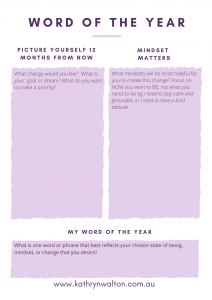 reflect. There is a free downloadable worksheet to help you do this on my website, or simply make notes in your own journal. Be careful not to get stuck thinking about all the reasons why ‘this’ can’t happen, and why ‘that’ wouldn’t work. This exercise is to help you focus on possibilities. Our brains spend enough time and energy on the problems, so let’s give it a break for a few moments!
reflect. There is a free downloadable worksheet to help you do this on my website, or simply make notes in your own journal. Be careful not to get stuck thinking about all the reasons why ‘this’ can’t happen, and why ‘that’ wouldn’t work. This exercise is to help you focus on possibilities. Our brains spend enough time and energy on the problems, so let’s give it a break for a few moments!
1. Picture yourself 12 months from now.
- What is one thing you would like to be different?
- What is one SMART goal you’d like to achieve in the next year?
- What is something you dream of, something you would like in your life?
- Even if you don’t have a specific goal or a dream, do you have a vague idea or a feeling that you’d like something to be different in your life?
- How would you like to be living your life?
- What attitudes or ‘ways of being’ would you like to be living by?
- What do you value most in your life? Are you living your life with these as your priority?
- Do any of your answers stand-out to you? Are there any common threads running through your reflections?
2. What states of being or states of mind will be helpful for you to achieve your goal, dream or desired change?
This is all about HOW you need to BE, not what you need to do, for example being patient, staying grounded or having a bold attitude.
3. What word or phrase best reflects the state of being or state of mind that YOU would most like to focus on over the next year?
This can be your word of the year!
4. Write your Word of the Year down, think about it often, and visualise how it will guide you through the year.
When you feel sure that’s the word you most need or want, plaster it everywhere to keep it fresh in your mind. Make it the centre piece of your vision board. Create a wallpaper for your computer or phone. Write in the front of next year’s diary. Blu tac it to your bathroom mirror. The idea is to get it front and foremost in your mind so that it does the job you intend it to.
Words of the month, week and day
A year is a long time, and sometimes it helps to have some stepping stones along the way. You can run through a similar process to choose a word of the month, week or the day.
In the bizarre way that the subconscious works, my word of the day often floats into my conscious mind during quiet morning meditation time. It can be a bit like a feather in the breeze, wafting around mid air until it gently settles on the ground. But sometimes my word of the day blasts at me in a song from the radio. Other times it’s gifted to me in the wise words from a loved one or even when I’m listening to a podcast interview. However it happens, I’m always happy to grab it and run with it, knowing it’s all part of the process to help me get from here to there, and in alignment with my overall goals and values.
I’d love to hear from you – have you ever chosen a Word of the Year? How did it help you create an attitude, mindset or a way of being to guide you towards your goal?

Discovering mountain biking as life’s ultimate parallel universe in her middle age, Kathryn Walton shares information and reflections in ‘Daisy Spoke’ that inform, inspire and empower women to a healthy and active lifestyle.


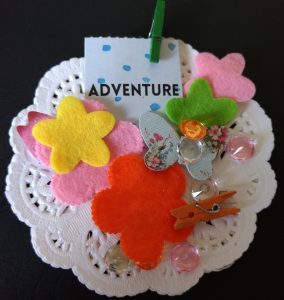

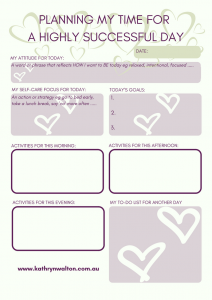


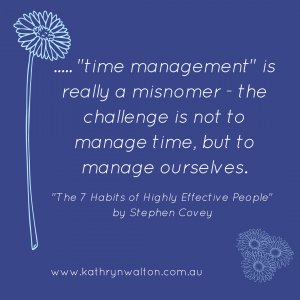


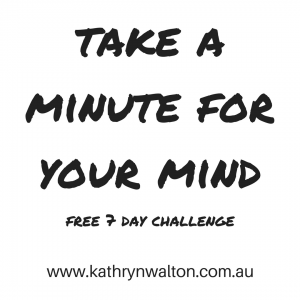






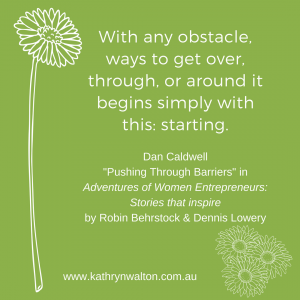


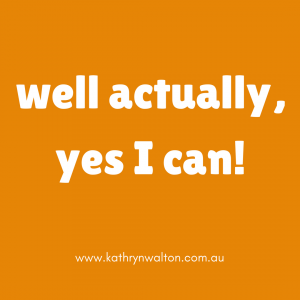
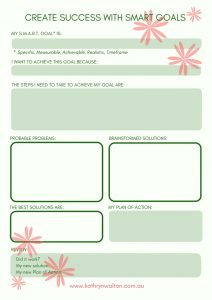
 Click here to read my last blog post
Click here to read my last blog post 
 example of mine was
example of mine was 
 You can collect them from songs, poems, books and social media in addition to listening to your own inner wisdom. Write them on sticky notes, in a journal or diary, print out visual reminders to stick around your home or workplace, or even use them as screen savers and wallpapers on your electronic devices. Some examples include “Just do it”, “One drop raises the ocean”, “Keep it simple”, “Just breathe”, “Stand tall”.
You can collect them from songs, poems, books and social media in addition to listening to your own inner wisdom. Write them on sticky notes, in a journal or diary, print out visual reminders to stick around your home or workplace, or even use them as screen savers and wallpapers on your electronic devices. Some examples include “Just do it”, “One drop raises the ocean”, “Keep it simple”, “Just breathe”, “Stand tall”.
 lying on the beach, your stresses trickling away into the sand beneath you) or to help you progress towards a goal (eg visualise yourself speaking in front of an audience, feeling confident, upright posture, smiling, relaxed). When I’m feeling nervous about riding my bike on a particular section of track, I stop for a few moments and picture myself riding it the way I want it to go, as if I’m watching a short video of myself successfully negotiating that section. It truly is a powerful mind-based strategy and one you can use in every area of your life.
lying on the beach, your stresses trickling away into the sand beneath you) or to help you progress towards a goal (eg visualise yourself speaking in front of an audience, feeling confident, upright posture, smiling, relaxed). When I’m feeling nervous about riding my bike on a particular section of track, I stop for a few moments and picture myself riding it the way I want it to go, as if I’m watching a short video of myself successfully negotiating that section. It truly is a powerful mind-based strategy and one you can use in every area of your life.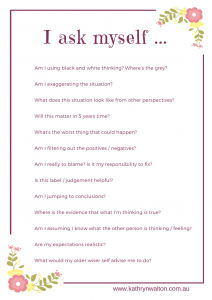 the mix. And to help you keep your strategies in play, I’ve created a free printable for you. “I ask myself …” is a beautiful keepsake of the helpful questions listed above. You can
the mix. And to help you keep your strategies in play, I’ve created a free printable for you. “I ask myself …” is a beautiful keepsake of the helpful questions listed above. You can 
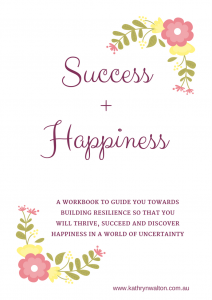 I have an EXCITING OFFER for you!
I have an EXCITING OFFER for you!